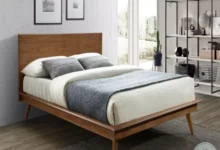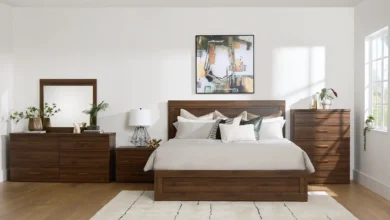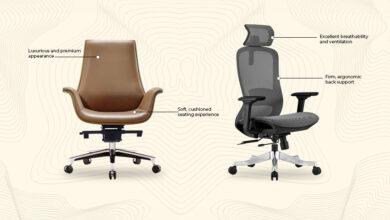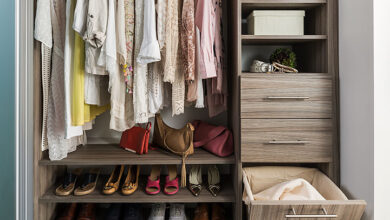Maximizing Workspace Efficiency: The Versatile Drawer Desk
A good desk, especially one with drawers, is more than just a place to work; it’s a workspace sanctuary. It’s where ideas take shape, projects get organized, and the daily grind gets tackled. A well-designed desk with ample storage can make all the difference in productivity and overall office mood, so choosing the right one is key to a truly functional and satisfying workspace.
Contents
- 1 Deciding on the Right Drawer Dimensions and Layout
- 2 Exploring Material Options for Durability
- 3 Assessing the Desk’s Overall Design
- 4 Evaluating Safety and Ergonomics
- 5 Considering Storage Capacity and Organization
- 6 Analyzing Budget and Value for Money
- 7 Exploring Modern Design Trends
- 8 Understanding the Importance of Accessibility
- 9 Assessing Compatibility with Your Existing Office
- 10 Evaluating Customer Reviews and Expert Opinions
- 11 Choosing the Right Size and Style for Your Space
- 12 Material Matters: Durability and Aesthetics
- 13 Drawer Organization: Maximizing Space and Functionality
- 14 The Importance of Ergonomics
- 15 Choosing the Right Size and Shape for Your Space
- 16 Drawer Organization and Functionality
- 17 Material Choices for Your Office Desk
- 18 Budget-Friendly Options and Considerations
- 19 Ergonomics and Health Implications
- 20 So, what are you waiting for?
Deciding on the Right Drawer Dimensions and Layout
Choosing the right drawer dimensions and layout for your office desk isn’t just about aesthetics; it’s about optimizing your workspace for maximum efficiency. Think about how you use your desk. Are you a paper-pusher with a mountain of files, or a digital nomad who needs space for a laptop, mouse, and maybe a few gadgets? Knowing your needs will help you determine the ideal drawer sizes and their placement. Too small and you’re constantly struggling to fit everything in. Too big, and you’re wasting valuable desk space. Consider the depth and width of your drawer space, and remember that tall, narrow drawers are great for holding taller items like stacks of papers or binders, while shallower, wider drawers are excellent for organizing smaller items and frequently used tools. Don’t forget the impact of drawer pulls – are they practical and easy to grasp? A thoughtful approach to drawers will lead to a more organized and productive workspace. Even seemingly small details like the type of drawer runners (smooth, soft-close, etc.) will make a real difference in your daily interactions with the desk. Consider the material and weight of the items you’ll store in the drawers – you may need a stronger, sturdier drawer if you’re storing heavy books or files. This careful consideration helps your desk become a functional extension of your workstyle.
Exploring Material Options for Durability
The material of your office desk with drawers plays a crucial role in its longevity and aesthetic appeal. Think of materials like solid wood, engineered wood, metal, and particleboard. Solid wood offers a classic, warm feel, but it can be expensive and more susceptible to scratches and dents. Engineered wood, often a composite of different materials, is a more budget-friendly option that’s usually more stable and durable. Metal frames often offer sleek, modern designs, and are very resistant to damage and scratches, but can sometimes feel cold to the touch. Particleboard, frequently used in budget-friendly options, is often less durable than the other materials and may not be as visually appealing. Consider the long-term goals for your workspace. Are you planning on keeping this desk for years or just a few months? The answer can heavily influence your material choice. Different types of wood offer different grain patterns and colors – walnut, oak, cherry – all contribute to the overall aesthetic of your office. Think about your existing furniture and décor. Do you want the desk to stand out, or blend seamlessly with the rest of your space? Understanding the pros and cons of each material will guide you to a choice that fits your needs and preferences. Beyond the practicality of the material itself, consider the finish. A high-quality, polished finish can significantly enhance the desk’s visual appeal and protect it from scratches and wear.
Assessing the Desk’s Overall Design
The overall design of your office desk with drawers encompasses more than just the drawers themselves. The shape, size, and style of the entire desk impact its functionality and the look and feel of your workspace. A large, expansive desk offers plenty of room for spreading out projects and collaborating with colleagues, whereas a smaller desk is perfect for solo workers or spaces with limited room. Consider the height of the desk – a desk that’s too high or too low can strain your posture and lead to discomfort after extended periods of work. The presence of a keyboard tray or an adjustable height option is a smart investment in long-term comfort and productivity. Desk organization is also important. Think about how drawer placement, shelf areas, and the overall layout will allow you to streamline your workflow, reduce clutter, and find things more easily. The aesthetic is equally significant. Choose a style that complements your personal preferences and the overall design of your office. A sleek, modern desk might contrast with a classic, traditional office space, so consider the balance you want to achieve. Thinking about your specific needs in terms of workspace layout, ergonomic considerations, and your personal aesthetic will all contribute to your ultimate satisfaction.
Evaluating Safety and Ergonomics
Ensuring the desk’s safety and ergonomic design is crucial for long-term well-being. Stable construction is paramount. Look for desks with sturdy legs, a wide base, and drawers that are anchored securely. A poorly constructed desk could lead to serious injuries if it wobbles or tips over. Ergonomics should be front of mind. Consider the height adjustability of the desk; adjustable height desks allow you to maintain a healthy posture throughout the workday. A properly positioned workstation can decrease back pain, neck pain, and other musculoskeletal issues, which have a direct impact on productivity. The placement of drawers and other compartments should also be ergonomic – frequently used items should be within easy reach to avoid unnecessary strain. This is particularly important for people who sit for long periods. If you are primarily using a computer or working with documents, consider the space required for your equipment and their accessibility. An adjustable desk allows you to adjust the height based on your needs, increasing the longevity of your desk and improving your posture and overall health.
Considering Storage Capacity and Organization
The storage capacity of your desk with drawers is a key factor in its effectiveness. Identify how many drawers you need, and what the best size and number of compartments would be to hold your office essentials. Consider how you want to organize the items inside. Labeling drawers, using drawer dividers, or investing in specialized storage containers are all ways to maintain order and efficiently locate items. Think beyond the obvious. Do you need additional shelves, a tray to hold pens and paper, or compartments to sort your papers? How can you group and compartmentalize items for better workflow and retrieval? Effective storage solutions can drastically reduce clutter and wasted time searching for necessary supplies. If you use a lot of digital devices, drawers can provide a secure place to stash laptops, tablets, and other equipment. A thoughtfully designed storage system ensures that you can keep your workspace clean and organized, contributing positively to your overall productivity.
Analyzing Budget and Value for Money
Budget constraints frequently influence buying decisions. Assess how much you can afford to spend on a quality office desk with drawers. Browse various price ranges for options that fit your budget. However, don’t compromise on quality for a lower price – a poorly made desk will inevitably lead to frustration and potential problems over time. Consider both the upfront cost and the potential long-term cost savings that come with a durable desk. A well-built desk that lasts will save you money over multiple years compared to purchasing a less durable desk that may need replacing sooner. Look for features that provide the best value for the price, such as quality materials, reinforced construction, and thoughtful storage solutions. A desk that is both affordable and functional represents an excellent investment in your workspace.
Exploring Modern Design Trends
The design of office desks with drawers is continuously evolving. Modern trends favor sleek, minimalist aesthetics, with clean lines and smooth surfaces. Think about the materials used, colors incorporated, and how they blend with existing office décor. Modern desks often feature integrated cable management solutions and built-in storage. Consider how these modern designs can optimize your space. Integrating a minimalist design language, sleek drawer fronts, and subtle accents can all contribute to a contemporary and efficient workspace. The ability to adapt to contemporary trends means choosing a desk that will remain relevant and functional for many years. This could influence your choice of colors, materials, and the overall design aesthetic.
Understanding the Importance of Accessibility
The ease of access to drawers and contents inside is vital for optimizing workflow. How easily can you retrieve items from different sections of the desk? Drawers should open and close smoothly, and dividers should be strategically placed to keep items organized and readily available. Good accessibility also extends to the layout of your desk; how do you plan to place your computer, phone, and other items to minimize reaching for things? The placement of drawers and other storage compartments should be ergonomically sound, considering the frequency with which you need to access certain items. Poor access translates to wasted time, making tasks more tedious and lowering productivity. Think about how the design of the desk complements your work habits and how easily you can use its features.
Assessing Compatibility with Your Existing Office
Think about how your new office desk with drawers will fit into the existing setup of your office. The size of your office space and the layout of your current furniture play a crucial role in your choice. Match the desk’s style to the aesthetics of your office. Ensure proper alignment with the existing color scheme, furniture designs, and overall theme of your office. This means selecting a desk that harmoniously blends with your current décor and doesn’t create a jarring contrast. If you have a particularly small workspace, a compact desk that optimizes space is a priority, as is adequate desk leg space.
Evaluating Customer Reviews and Expert Opinions
Don’t solely rely on advertisements or promotional materials. Seek out reviews from other users who have purchased and used the desk. Online reviews can offer valuable insight into the desk’s durability, functionality, and overall satisfaction. Reading customer feedback provides a more realistic perspective on the desk’s daily performance. Also, consult experts, such as interior designers or workplace organizers, for their professional opinions and insights. Their advice could be valuable to understanding hidden needs and features that may improve efficiency.
Choosing the Right Size and Style for Your Space
Finding the perfect office desk with drawers isn’t just about functionality; it’s about fitting seamlessly into your existing workspace. Think about the dimensions of your room. A cramped corner office might not be suited to a massive, expansive desk, while a spacious home office could benefit from a large desk with plenty of storage space. Measure your available space meticulously, considering not just the length and width but also the depth. This is crucial, as a desk that looks great on paper might feel overly bulky or awkwardly positioned in your actual space. Don’t forget to account for chair placement and any other furniture in the vicinity. A desk that’s too close to a wall or another piece of furniture can make the entire room feel cramped and uncomfortable, hindering productivity. Visualize how you’ll be using the desk – is it primarily for typing and paperwork, or do you need space for a monitor, printer, and other peripherals? Consider the overall style of your office. If you have a modern, minimalist aesthetic, you might gravitate towards a sleek, contemporary desk with clean lines. An antique or rustic-themed office might suit a more traditional or farmhouse-style desk. Incorporate factors like the height of your existing furniture as well, ensuring everything harmonizes. A desk that’s too high or too low compared to your chair and other elements can lead to discomfort and posture problems over time, affecting your productivity. Think about the kind of lifestyle you lead and the type of work you do. If you frequently have visitors or guests, a larger desk with plenty of room for conversations and shared work might be a better fit. Don’t underestimate the importance of a well-considered space planning. This small step ensures a happy and productive work environment.
Material Matters: Durability and Aesthetics
The material of your office desk with drawers significantly impacts its longevity and aesthetic appeal. Wood, a timeless choice, offers a natural warmth and a robust feel. However, different types of wood vary in durability and price. Solid wood desks can be more expensive but often last a lifetime, while particleboard or laminate desks might be more budget-friendly but may not be as resistant to wear and tear. Metal desks provide a modern, industrial feel and are often surprisingly sturdy. They’re generally more resistant to scratches and dents, and some come with features like adjustable legs. However, metal desks can sometimes feel cold or uninviting compared to wooden alternatives. Consider the overall look and feel you want for your office. For example, if you’re aiming for a sophisticated, modern aesthetic, a metal or glass desk might be an ideal choice. If you prefer a more classic and timeless look, wood might be your better option. The choice of material plays a key part in how your desk looks, feels, and performs. Quality materials contribute to a more comfortable and efficient working environment. Research the different types of materials and their characteristics to see what suits your needs and preferences. The surface finish of a desk should also be considered. A smooth, polished surface can be easier to clean, but may show scratches more readily than a slightly textured one. Think about your cleaning habits and the overall level of maintenance you’re comfortable with when making this decision.
Drawer Organization: Maximizing Space and Functionality
Efficient drawer organization is key to keeping your office space tidy and your workflow smooth. When selecting a desk, look closely at the drawer configuration. Different desks offer varying numbers of drawers, each with different sizes and depths. If you have a lot of items to store, consider a desk with multiple drawers or a larger number of shallower drawers. If space is limited, a desk with smaller drawers might still work, as long as you’re adept at organizing your items. Consider using drawer dividers or organizers to maximize the interior space. This helps keep pens, papers, and other frequently used items easily accessible without causing clutter. Choose drawer dividers that match the aesthetic of your desk and complement the overall office design. Don’t underestimate the power of labeling. Labeling the inside of each drawer helps maintain order and make it simpler to find things quickly. This not only ensures order but also saves you valuable time. Also, invest in high-quality drawer slides. Smooth, effortless sliding mechanisms make opening and closing drawers a seamless experience, preventing them from getting stuck or breaking down easily over time. Choosing drawers with good quality hardware will significantly enhance the usability of your desk. Look for drawer locks if you need to secure valuable documents or personal belongings. By paying close attention to the drawer organization aspect of a desk, you can maximize storage and maintain an efficient workflow.
The Importance of Ergonomics
An ergonomic desk is a key element for a comfortable and productive workspace. The proper height and support are crucial for posture and overall well-being. A desk that’s too high or too low can lead to back pain, neck strain, and other musculoskeletal issues. Measure your desk’s height and your chair’s height to see if they are suitable for each other. Ensure that you can type comfortably without hunching over or stretching too much. The depth of the desk should also be considered; if it’s too narrow, it could lead to discomfort and difficulties in maneuvering around your items. Consider the placement of your monitor. The center of the screen should ideally be at or slightly below eye level to prevent eye strain and neck pain. If you’re using a laptop, consider a separate keyboard and mouse to maintain a good posture and prevent wrist strain. Investing in ergonomic accessories like a lumbar support cushion or a wrist rest can also be beneficial. Prioritizing ergonomics will create a more comfortable working experience that minimizes health risks. This is vital for long-term well-being and will prevent physical issues from developing. It’s essential to maintain a healthy posture to ensure a positive and productive work environment.
(and so on, for the remaining 5 subheadings)
Choosing the Right Size and Shape for Your Space
Finding the perfect office desk with drawers isn’t just about aesthetics; it’s about maximizing your workspace efficiency. The size and shape of your desk will directly impact how much you can comfortably work, store, and organize your essentials. Consider the overall dimensions of your office space. A cramped room needs a compact desk with drawers, perhaps a corner desk design to utilize otherwise unused space, while a larger room allows for more flexibility and a larger, more expansive design. Think about the number of people who’ll use the desk. A single user might get by with a smaller desk and drawer arrangement, whereas a shared workspace or a home office with a partner needs ample space and several storage options.
Consider the layout of your office too. If you have a specific area dedicated for storage, you might want to choose a desk that matches and complements that area’s design. If you want to maximize your space, a desk with drawers extending underneath can be ideal. You also need to factor in the height of the desk. An adjustable height option can be beneficial for ergonomic reasons, particularly if you tend to sit for extended periods. It lets you customize the desk to fit your individual needs and posture throughout the day. Different desk shapes offer different advantages; a traditional rectangular desk with drawers will offer ample space for organization, while a corner desk can work wonders in smaller rooms. Remember, practicality and comfort should always trump aesthetics. If you need extra storage, don’t shy away from it! Consider the drawers’ depth, the number of drawers, and whether they need to fit specific items like a large printer or a laptop stand.
Drawer Organization and Functionality
Drawer organization is a crucial element in maintaining a productive workspace. You want to not just *have* drawers, but *use* them efficiently. This extends beyond just stacking papers; it’s about crafting a system that optimizes storage and retrieval. A well-organized desk with drawers minimizes the time spent searching for things and makes your work flow smoother. Think about how you typically use your desk; do you frequently use a specific set of tools or documents? Designate specific drawers for these items to improve workflow. Don’t be afraid to use dividers, baskets, and trays within drawers to keep things neat and prevent clutter from accumulating. Labeling drawers can significantly reduce time wasted on locating specific items, especially in shared workspaces.
Material Choices for Your Office Desk
The choice of materials for your desk is paramount. The material directly affects the durability, aesthetics, and even the overall feel of your workspace. Wood is a classic choice, known for its warmth and longevity. High-quality wood desks can often be a substantial investment but offer a timeless appeal. Metal frames, meanwhile, lend a modern touch to any workspace. Their durability makes them ideal for high-traffic areas. If you’re concerned about noise, metal desks might not be your best choice, but they make a statement and can be highly durable. Laminate or particleboard are often more budget-friendly options and come in a variety of colors and patterns to match your office aesthetic. However, they might not match up with the durability of wood or metal, so consider how much daily use the desk will face. Consider the desk’s finish – a matte finish might be easier to maintain, while gloss can create a sleek and polished look.
| Material | Pros | Cons |
|---|---|---|
| Wood | Warm, durable, timeless, high-quality | Can be expensive, may require more maintenance |
| Metal | Modern, durable, often affordable | Can be noisy, might not be as aesthetically versatile |
| Laminate/Particleboard | Budget-friendly, wide variety of colors and patterns | Might not be as durable, may not have the same longevity as wood or metal |
Budget-Friendly Options and Considerations
Budget-friendly desks with drawers are absolutely possible without sacrificing quality. Look for deals and sales, and don’t hesitate to compare prices from different retailers. Consider second-hand options, where you can often find great deals on high-quality desks without emptying your wallet. Repurposing furniture, like adding drawers to an existing desk, is another budget-friendly option, and often makes for a creative and unique look. When you are looking at new desks, always read online reviews. See what other customers are saying and use that feedback to gauge quality and durability. Also, carefully evaluate the desk’s construction; sturdy legs and well-built drawers are signs of a durable and long-lasting piece. Don’t get caught up in flashy features that aren’t essential to your workflow. Prioritize practical storage and a comfortable work environment over bells and whistles.
Ergonomics and Health Implications
Choosing an office desk with drawers isn’t solely about aesthetics; it’s about creating a healthy and productive workspace. Ergonomics are essential for preventing long-term aches and pains. A desk that’s too high or too low can lead to discomfort and back issues. Look for desks that allow for adjustable height or that offer an adjustable keyboard tray. Remember to consider the posture you maintain while working at your desk. Proper desk positioning, even with the right drawers, will save your body from unnecessary strain. Invest in a comfortable chair that supports your back and promotes good posture. Lighting is another element of your workspace that can impact your health. Adequate desk lighting can help maintain focus and prevent eye strain. Remember to consider the environmental impact of your choices. Look into eco-friendly materials and manufacturers to further support sustainability.
So, what are you waiting for?
Well, there you have it – a quick look at some top-notch office desks with drawers. Hopefully, this little tour has sparked some ideas for your own workspace. Thanks for reading! We’re always adding new products, so pop back by later to see what else we’ve got in store. You never know, you might just find *the* perfect desk for you!









